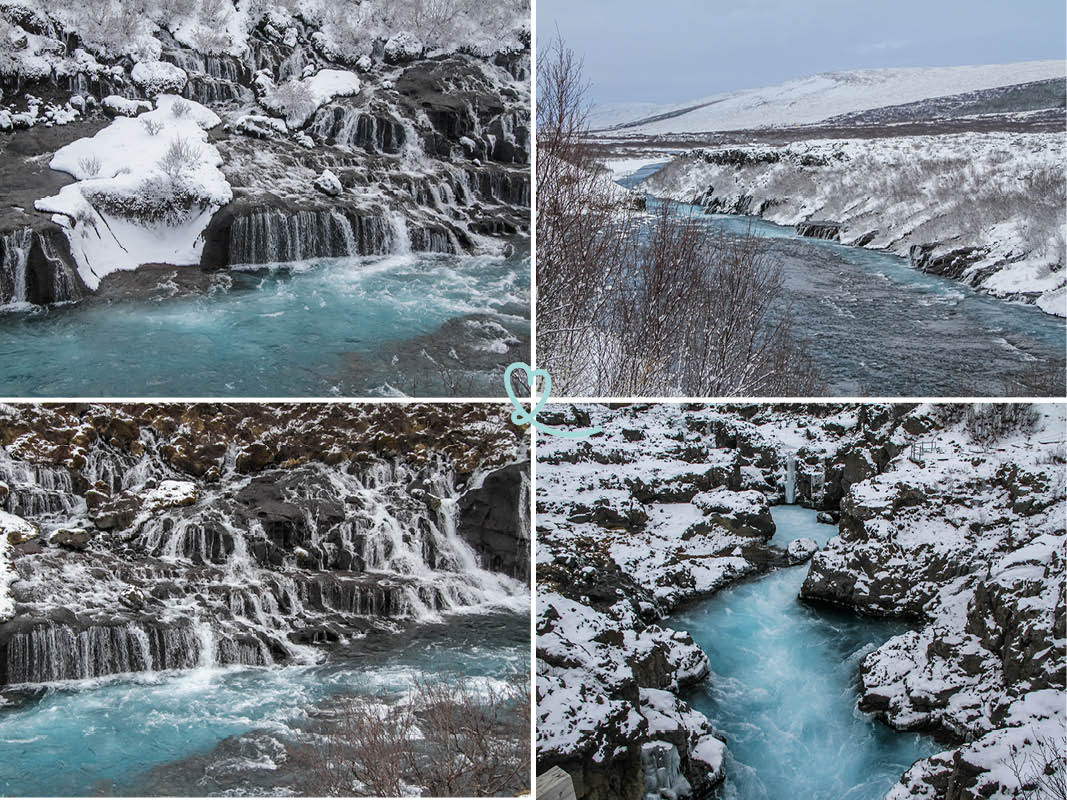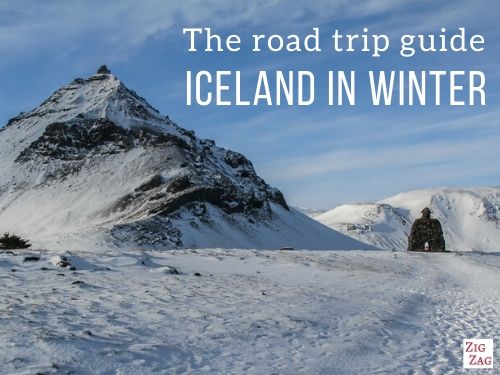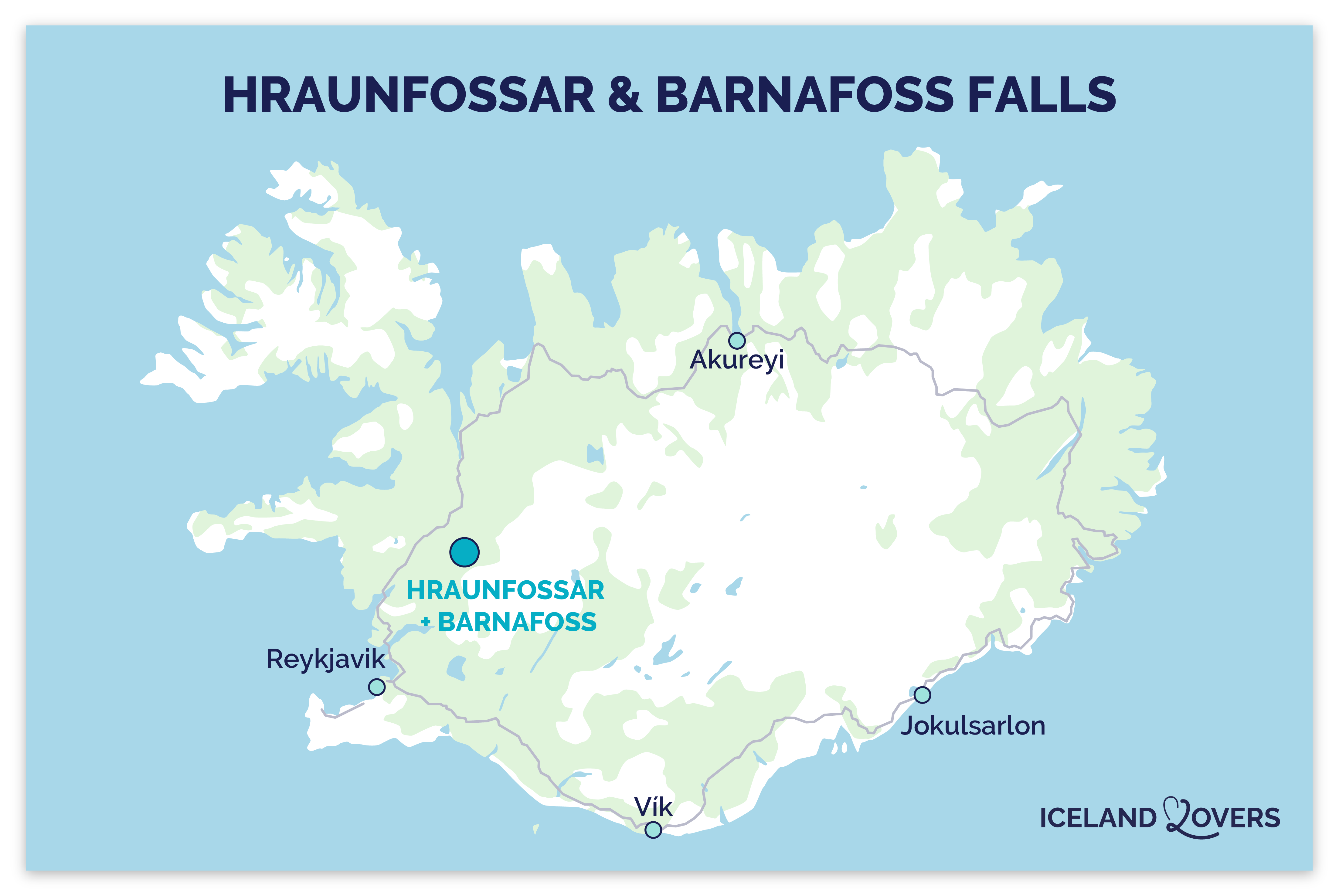Discovering the Hraunfossar and Barnafoss waterfalls was certainly one of the most striking moments of our winter trip to Iceland! We had the chance to admire them in both summer and winter, and the comparison is astonishing. Between November and March, thousands of unique flows cut through the lava, combined with the intense blue of the water and the white of the snow. The result is a magical landscape.
Here are some useful tips to help you plan your visit and enjoy an unforgettable getaway!

This opinion is completely independent, based on our experiences. We visited the region anonymously, making our own choices and paying our bills in full.
Content
Why visit the Hraunfossar and Barnafoss waterfalls in winter?
Are the Hraunfossar and Barnfoss waterfalls worth a visit? Our opinion:
Yes, these 2 waterfalls are well worth a visit in winter.
Inland on the Snaefellsnes Peninsula, you can explore the Silver Circle, where these waterfalls are located.
Less famous than the Golden Circle, the highlight of this loop is the Hraunfossar Waterfall, a protected natural site since the late 1980s.
We contemplated thousands of small waterfalls emerging from the lava rocks, an impressive sight and a unique landscape!
And with the luminous white of the snow, it’s even more enchanting than in summer.
We count them among the most beautiful waterfalls to see in Iceland in winter, and one of the best attractions in the Silver Circle.

Our favorite moments
We’ll describe our winter experience at Hraunfossar and Barnafoss in detail later in this article, but we wanted to share our favorite moments with you:
- details of the thousands of small Hraunfossar waterfalls, some of which freeze over in winter
- the narrow, sparkling blue canyon into which the Barnafoss waterfall plunges

OUR GUIDE TO PLANNING A Dream trip
- 6 maps that make planning easier
- + 75 pre-selected locations
- Practical advice
- + 115 photos to help you choose

How to get to the Hraunfossar and Barnafoss waterfalls in winter: access and map
Where are these waterfalls?
- On the Silver Circle, inland from the Snaefellsnes Peninsula
- On Route 518
- From Reykjavik = 1h drive
- From Borgarnes = 1h drive
- From Husafell = 10min drive
- Here is a map to help you find your way:

RENTING A CAR IN Iceland
Discover the best offers on Discovercars, our preferred platform!
On Route 1, no 4WD required, off Route 1, it depends on your plans.

How to get there? Access road
In winter, you have 2 options for getting to the Hraunfossar and Barnafoss waterfalls:
- Guided excursion from Reykjavik: this is our preferred option if you don’t want to drive in winter, but want to enjoy the scenery at your leisure. Day or multi-day excursions are possible to the Cercle d’Argent, including the 2 waterfalls. Guided tour drivers are used to winter roads and weather conditions.
- By car: Reykjavik is less than 2 hours’ drive from Hraunfossar on route 518, which is very popular with tourists and is regularly cleared of snow in winter. If you always drive carefully during the day, you can easily rent a car on site and get there on your own, giving you more freedom of movement.
Normally, the roads are cleared quickly enough for access. But during snowstorms, roads may be closed at the last minute – always check the status of roads on Umferdin.

Parking
This protected natural site has a free, flat parking lot that’s easy to get around. To admire the 1st waterfall, it’s just a 5-minute walk from the parking lot. A loop can be made on foot to visit the 2 waterfalls, with no need to use your car between the 2.
WHERE TO STAY IN Iceland
Our independent picks for the accommodation of your dreams:
- Where to stay in Iceland (coming soon)
- Where to sleep in Reykjavik (coming soon)
- Best 5-star hotels (coming soon)
- Where to sleep on the South Coast (coming soon)
- Where to sleep on the Golden Circle (coming soon)
- Where to sleep on the Snaefellsnes peninsula

Useful tips: duration, schedules, difficulties…
Best time to visit, opening hours and prices
The waterfalls are accessible from November to March, throughout the winter period.
The days are shorter, especially from December to February, so we recommend you take this into account for your visit.
This natural site is accessible all year round, 24 hours a day (except in special weather conditions), but we advise you to visit when it’s light out.
Access to parking lots and attractions is free.

Length of visit and main difficulties
Allow between 30min and 1h to see it all.
We recommend you allow 1h as the place is fascinating and you should take your time to really appreciate it!
Although they are regularly cleared of snow to make it easier to get around during your visit, bear in mind that the ground can be slippery due to ice or snow.
The path between the 2 waterfalls, Hraunfossar and Barnafoss, is maintained in winter.
You’ll find it easy to walk along.
However, note that the path to the left of the Hraunfossar platform, along the Hvita River platform, is only clear for 100m.
Despite the winter conditions, be aware that this spot can also be subject to tourist crowds, especially during the day when the light is at its brightest.

For your own safety, we recommend that you respect the areas closed to the public and the warning signs. Don’t forget to bring warm clothes and good shoes to feel comfortable.
Advice on how to visit
The direction of your visit is not prescribed. We suggest you start by turning left from the parking lot, admire the Hraunfossar waterfall and then walk along the river towards Barnafoss. Return in the opposite direction along the Hvita River or by the other, more direct route.

Visiting with children
Like most natural sites in Iceland during winter, this is a great place for the whole family to discover! If you’re visiting the Hraunfossar and Barnafoss waterfalls with your children in winter, dress them warmly like you, with several layers. Don’t forget to fit them with shoes that won’t slip on snow or ice, and there are crampons for children. Take a break to warm up in the restaurant with toilets, and adapt your visit to the time you have available. Finally, opting for a child-friendly guided tour can be a safer and more child-friendly option.
Catering, Toilets and Facilities
The following facilities are available on site:
- free parking, easy to access and flat to move around in
- a restaurant normally open all year round
- pay toilets near the parking lot

UNFORGETTABLE ACTIVITIES IN winter
- Visit an ice cave
- Glacier hiking
- Whale watching (from Reykjavik, Husavik or Akureyri)

The Hraunfossar waterfall, an enchanting winter spectacle
Protected since 1987, Hraunfossar is one of our favorite waterfalls, whether in summer or winter.
We realized that it’s very different from any other waterfall in Iceland.
Here, thousands of streams flow between the lava rocks.
We felt a great sense of serenity as we carefully observed the movement of the water and the path it carves along the rock formations.
In winter, you’ll notice that the view becomes tricolored: the black of the dried lava, the white of the snow and the intense blue of the glacial river.
It’s a truly magical winter landscape!

Lava Falls” under the snow
Did you know that the name “Hraunfossar” literally means “lava falls”? On site, if you take a close look at the waterfall, you’ll see that the water flows through the rocks of the Hallmundarhraun lava field. It glides down a mere 1 m in gentle cascades into the Hvita River. You’re probably wondering how this lava field came to be. We’ve learned that it’s the result of a volcano eruption beneath Langjökull. Europe’s 2nd largest glacier, it concentrates a volcanic system, the Oddnýjarhnjúkur-Langjökull, which has erupted twice in over 5,000 years. The lava field boasts numerous caves, the most famous of which is the Vidgelmir lava tube. We urge you to add it to your bucket list!

This natural site is literally mesmerizing!
Take your time to appreciate the many waterfalls: some plunge straight into the river, while others dance over the rocks.
Some can freeze, creating ice sculptures.
This waterfall is around 900m wide – impressive, isn’t it?
In fact, we had a hard time getting a picture of it all in the frame!

The path between the waterfalls
Once you’ve marvelled at the Hraunfossar waterfall and its dried lava waterfalls, don’t leave just yet, because there’s more to come!
From the platform, we followed the river.
The color gets bluer and bluer as the canyon narrows, can you see it?
Access to other observation platforms remains fairly easy.

Subscribe to our Newsletter
- Get away from it all with Region Lovers’ beautiful destinations!
- Once a month
- Advertising-free
The legend of Barnafoss and the narrow, azure canyon
After arriving at these observation platforms, we admired the Barnafoss waterfall.
You’ll be amazed to know that this is a completely different experience from Hraunfossar.
Here, water from the Hvita River rushes down a narrow canyon.
The lava has formed a small bridge under which the water swirls.
We were mesmerized by this moving phenomenon.
The blackness of the lava rock, the blue of the water and the white of the snow make for an almost unreal landscape, straight out of a fantasy tale!
If you close your eyes and concentrate on the gentle sound of the waterfall, you’ll feel the magic of this place!
Unlike some of the more powerful waterfalls in Iceland, a country famous for its waterfalls, you won’t hear any noisy torrents on site!

This waterfall, like many in Iceland, is also known for the legends that surround it, this one a fatal one.
The story goes that a woman lived on a nearby farm with her 2 children.
While she was at church, the children went off to play.
When she returned, they were gone.
Footprints were found all the way to the stone arch over the river.
Devastated, the mother had the stone bridge destroyed so that no one would cross the river again.
In another version of the story, she cursed the bridge with an Icelandic rune, a magical Icelandic symbol dating back to the Middle Ages, so that anyone crossing it would suffer the same fate.
This is how we came to understand that “Barnafoss” means “children’s falls”.
A sad legend indeed!

Crossing the Hvita River
Did you know that the 40km-long Hvita River is also known as the “White River”? You’ll notice its milky appearance and Claire color, typical of glacial rivers! It rises in the famous Langjökull glacier and flows into the Gullfoss waterfall, north-east of the Golden Circle. Near the Hraunfossar and Barnafoss waterfalls, you’ll see a bridge crossing this river. We enjoyed the view just below.

However, the other end of the bridge with the path leading to the upper platform is closed in winter. We loved the peaceful movement of the water as it meandered along before flowing into the Hvita River, Iceland’s 10th longest and renowned for its blue color.

So, like us, you’ll have to stop on the bridge if you’re going there in winter. But rest assured, you won’t be disappointed – it’s already a wonderful experience!

Other nearby attractions
You can combine your visit to the waterfalls with these nearby attractions:
- City of Reykholt and its history museum (20min drive)
- Langjökull Ice Tunnel, Europe’s 2nd largest glacier (10-minute drive)
- Vidgelmir lava cave, Iceland’s hidden treasure (20min drive)

Frequently asked questions
Do I need special winter equipment?
If you’re traveling to Iceland in winter, remember to take waterproof clothing that will keep you warm, such as boots, a warm jacket, several layers of clothing, gloves, a hat… Be aware that the weather can change rapidly in Iceland, so plan to be able to add or remove layers of clothing easily. On organized tours, equipment such as snow crampons or complementary windproof or waterproof suits can be provided. Please check with the tour operators when booking your trip.

Are waterfalls different in summer and winter?
These 2 waterfalls are quite unusual in Iceland. Firstly, because they are less powerful and less noisy than others, but also because you can’t move behind them. In summer, Hraunfossar and Barnafoss are surrounded by greenery, as well as the colors of water and dried lava. It’s a beautiful sight in summer, but definitely more bewitching to our eyes in winter!
How do I get to the Hraunfossar and Barnafoss waterfalls from Reykjavik in winter?
From Reykjavik, the only way to reach the Hraunfossar and Barnafoss waterfalls in winter is by road. In less than 2 hours by car, you can reach the waterfalls from the capital by joining main road 1 (which circles the island) and then road 50, which winds its way up through Reykholt before arriving at the cascades.
Normally, the roads are cleared quickly enough for access. But during snowstorms, roads may be closed at the last minute – always check the status of roads on Umferdin.

Read our tips for renting a car in Iceland here. You’ll need to be careful and experienced in winter snow driving.
If you don’t want to drive, the best option is a guided tour from Reykjavik.
The drivers are experienced locals who are used to driving in very cold conditions. see options
PLAN YOUR TRIP TO iceland IN WINTER
- Best of
Iceland’s winter landscapes
Best things to do in Iceland in winter
The most beautiful waterfalls
Ice caves
Best excursions from Reykjavik

- Practical advice
Getting around (coming soon)
How to rent a car in Iceland
Winter driving tips
Where to stay in Iceland in winter
Itineraries: 3 days – 4 days – 5 days – 1 week – 10 days (to come)

- The must-dos
Reykjavik in winter
Golden Circle in winter
South coast in winter
Snaefellsnes in winter
Silver Circle in winter (coming soon)
Lake Myvatn in winter
Eastern Fjords in winter
Seljalandsfoss in winter
Jokulsarlon in winter


SHE MADE THE TRIP Claire



